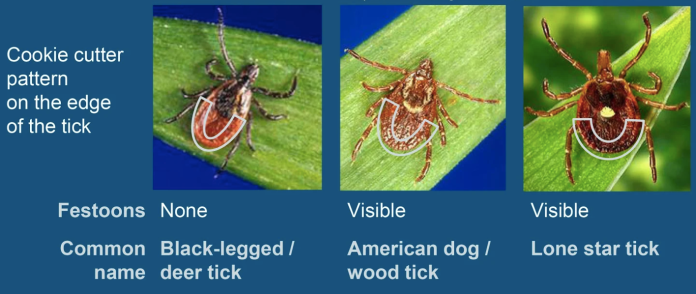Identify a tick
There are a lot of tick species in the United States, but only a few bite humans. The ticks included below are commonly found on humans and pets in the Northeast and Midwest. You might need a magnifying glass or you may need to zoom in on a picture to see the details on your tick. Nymphs are very small!
Synonyms
- Black legged tick = deer tick = bear tick = Ixodes scapularis
- American Dog Tick = wood tick = Dermacentor variabilis
- Lone star tick = Amblyomma americanum
- Visit the following websites to learn more about tick species
Ticks can be big and small
The size of a tick is dependent on:
-
- Life stage
- Species
- Male or Female
-
- How much blood they have ingested


The dog / wood tick is the bigger than the blacklegged / deer tick and the lone star tick.

After a full blood meal:
- Nymphs can become as big as an unfed female adult (apple-seed size)
- Adults can become as big as a pea or even bigger in the case of the dog/wood tick

The shield (scutum)
- The shield of male ticks covers the whole body
- The shield of female ticks and nymphs cover just the front part of the body
- The pattern on the shield helps identify tick species
- The shield can be hard to see when a tick has taken a blood meal.

Cookie cutters (Festoons)
Cookie-cutter pattern on the edge of the tick

Powerpoint: Tick identification
Tick identification services
Several universities, public health agencies, commercial companies and other entities offer tick identification and pathogen testing of your tic
Different tick species transmit different pathogens, so it helps to know which species bit you. You can send the image of your tick or tick to us, but we are not testing them. Even if a tick is tested for pathogens and none were detected, that does not mean that there is zero chance of you developing a disease. There is the chance that other ticks might have been attached to you and gone unnoticed (they are very small!).
Submit a picture:
- In the Tick App you can submit your Tick report and picture through a pop up website. We hope to have this option integrated in the app in 2019 (or sooner)!
- From Wisconsin? Click here to submit the story and pictures to the Wisconsin Medical Entomology Laboratory at the University of Wisconsin – Madison part of the Midwest Center of Excellence for Vector-borne Disease.
- From anywhere? www.tickspotters.org OR try your extension contact of insect diagnostician.
Submit the actual tick for ID and testing:
- Submission not restricted
- https://www.tickreport.com/, $50 to 200 per tick
- General public submission to Cornell University ($100 for one and up to 6 ticks from one location)
- Ticknology, $25 per tick
- Submission restricted
- Connecticut residents only: Free, http://www.ct.gov/caes/cwp/view.asp?a=2837&q=378220
- Department of Defense personell and dependents: Free, https://phc.amedd.army.mil/topics/envirohealth/epm/Pages/HumanTickTestKitProgram.aspx



